Slow drains are nuisances that build over time. Slow draining water is often the first signal you have a drain clog. A drain clog can lead to water damage. Learn the options for getting rid of buildup and clogs in your plumbing. You can follow these tips to unclog the drain yourself, or if you don’t have the time or feel confident in solving the problem without causing damage, call us at Fite Plumbing and we can help! We are just a call away! 317-271-5400
Why a drain clog can develop
Drain stoppers, P-traps, and horizontal sections of pipe are areas that can commonly clog. Many things can cause a drain clog. Here are just some examples:
- Soap Residue
- Grease Build Up
- Hair
- Hard Water Deposits
- Foreign Objects – Toy, Jewelry, etc.
- Food
- Paper
Feeling handy? Do it yourself
There are many options to help you clear a clogged drain. With care you can actually take care of a drain clog yourself. Of course, that depends on where the clog is located. Understand the options available to the DIYer.
Chemical Cleaners
You can purchase chemical cleaners to pour down the drain. These liquids are heavier than water, so they are able to pass through the water and reach whatever is clogging your drain. Some of the products foam and fill the pipe to reach the block. Often the active ingredients are potassium hydroxide, sodium hydroxide, sodium hypochlorite, or sulfuric acid. These products help to soften whatever is blocking the drain and help allow it to pass through.
Maintenance
Some of these chemical cleaners recommend regular use to continue to clear away build up in pipes before they cause a clog.
Warnings (IMPORTANT!)
Be sure to follow the manufacturer’s directions on use of these chemicals. Used improperly can cause damage to your pipes or hurt humans and pets. Keep the following cautions in mind:
- Be sure first that the product is one that is intended for the type of plumbing system in your home. For example, certain products are labeled for use with a septic system and some are not.
- Match the product to whichever fixture is clogged: sink, tub, toilet, shower…
- Do not mix products. If one product does not work, do not immediately try another.
- Do not allow the product to remain in the drains longer than the instructions indicate. This can cause damage to your system.
- Wear personal safety gear such as gloves, eye protection, or any protection recommended by the product manufacturer. Remove children from the area.
- Be sure to keep the chemical product away from the finished surfaces of your fixtures such as the faucets, stoppers, drain trim, or porcelain.
- Do not try to use a plunger or drain opening tool on a clog after using a chemical. This can cause chemicals to splash up and contact you or other surfaces.
Tools to attack a drain clog
There are many tools that can assist you in unclogging a drain. Not all of them are tools you might commonly find in a household. Understanding what they are and how to use them will help you make a decision at the hardware store before you begin the project to remove a drain clog.
Plunger – A plunger is a common tool used to clear clogs in toilets, sinks or tubs. They work well on a clog that is in the drain trap area. The rubber bell and the plunging action creates a suction effect to break up, pull up, or dislodge blockage. The deeper the rubber cup on the plunger, the more force will be applied. A plunger with bellows or an accordion design provide even more force. Flat cup plungers work best for sinks and tubs. Cone or funnel shaped cups on plungers work best for toilets.
Drain Stick – A drain stick is a flexible rod or strap that can be inserted into a drain to remove hair. A drain stick works well in the P-trap but is typically not long enough to reach deeper. All that you need to do is push the stick into the drain and then pull it back out. Hopefully, whatever is clogging the drain will get caught on the stick and pull out. It may have hooks or barbs on the stick to help catch material that is in the clog.
Snake – A snake, also known as a hand auger, is useful to reach clogs that are further down the drain than the drain stick can reach. It is a flexible cable with a handle on one end and sharp coil on the other. As you push the cable, rotate it around and navigate bends and turns in the pipes. The coil at the end will hit the clog and hopefully catch it to allow you to pull it out.
Auger – There are a few variations on an auger. Augers come in different lengths. The longer the auger, the deeper you can reach into the drain, but you may have less control. An auger especially for a toilet has a protective sleeve around the cable to protect the porcelain. Some augers have a drum to house the cable. Some have different shaped grips to make it easier to control. Others have an adapter to attach to a power drill to turn the cable. A tape auger is flat instead of a round cable and may allow you to push the clog through the pipe rather than pull it out. Finally, large machine augers are high power devices and are typically used by professional plumbers.
Bladders – A bladder can be used for a clog, but you will need a helper. It can be tricky. The bladder is attached to a garden hose and is fed into the pipe that is clogged. When you reach the clog, have a helper turn on the water to the hose. The bladder will fill with water and expand. Once the bladder fills the size of the pipe it will discharge the water in a high-pressure stream that will loosen the clog and hopefully push the clog out. Bladders come in different sizes for different pipe diameters. There are also adapters for the bladder to allow you to connect your garden hose to an indoor faucet. When moving a bladder through turns in the pipe, be sure that you are only twisting the hose to the right, to keep it tight to the bladder. Twisting it to the left could cause the hose to become loose on the bladder. (“Lefty Loosey, Righty Tighty!”)
These are the options for how to unclog a drain yourself. Some are more difficult to use, and, of course, your success with them can hang on what the clog is made of and where it is in the plumbing. It could be easier – and safer – for you to save yourself (and your family) all the trouble and aggravation. In that case, just call us at Fite Plumbing! 317-271-5400 Our plumbing pros can get it done so everything is flowing smoothly again.
Are you on Facebook? We are, too. Let’s be friends!


